Fundamentals of Project Management
VerifiedAdded on 2023/01/11
|21
|5052
|33
AI Summary
This project report covers various aspects of project management for Automatic Futures (AF) PLC, including the importance of iron triangle in determining project objectives and goals, identification of risks during project implementation, preparation of network diagram and Gantt chart.
Contribute Materials
Your contribution can guide someone’s learning journey. Share your
documents today.

Fundamentals of Project
Management
Management
Secure Best Marks with AI Grader
Need help grading? Try our AI Grader for instant feedback on your assignments.

Contents
EXECUTIVE SUMMARY.............................................................................................................3
INTRODUCTION...........................................................................................................................1
TASK 1............................................................................................................................................1
A. Importance of various parameters of iron triangle in determining the overall Project
objectives and goals.....................................................................................................................1
B. Identification of the risks that are likely to emerge during the course of project
implementation by AF Plc with the help of risk register.............................................................3
TASK 2............................................................................................................................................8
A. Preparation of a network diagram to show the critical path and planned duration of the
project..........................................................................................................................................8
B. Preparation of a Gantt chart for the project.............................................................................9
C. Details of overall projected budget and calculation of the projected net profit of the
contract........................................................................................................................................9
TASK 3..........................................................................................................................................12
A. Comparing the actual progress with the planned progress using Gantt Chart......................12
B. Production of a revised Gantt chart and analysis of the impact on project completion date
and expected costs and profit.....................................................................................................13
TASK 4..........................................................................................................................................15
A. Using EVA determine the overall actual percentage of work completed and compare it with
overall actual planned percentage of work completed..............................................................15
B. Create a project final spend and date using EAC method derived from Earned Value
Analysis.....................................................................................................................................17
C. Recommendation for which of the options should be accepted and which should be
declined......................................................................................................................................17
REFERENCES..............................................................................................................................19
EXECUTIVE SUMMARY.............................................................................................................3
INTRODUCTION...........................................................................................................................1
TASK 1............................................................................................................................................1
A. Importance of various parameters of iron triangle in determining the overall Project
objectives and goals.....................................................................................................................1
B. Identification of the risks that are likely to emerge during the course of project
implementation by AF Plc with the help of risk register.............................................................3
TASK 2............................................................................................................................................8
A. Preparation of a network diagram to show the critical path and planned duration of the
project..........................................................................................................................................8
B. Preparation of a Gantt chart for the project.............................................................................9
C. Details of overall projected budget and calculation of the projected net profit of the
contract........................................................................................................................................9
TASK 3..........................................................................................................................................12
A. Comparing the actual progress with the planned progress using Gantt Chart......................12
B. Production of a revised Gantt chart and analysis of the impact on project completion date
and expected costs and profit.....................................................................................................13
TASK 4..........................................................................................................................................15
A. Using EVA determine the overall actual percentage of work completed and compare it with
overall actual planned percentage of work completed..............................................................15
B. Create a project final spend and date using EAC method derived from Earned Value
Analysis.....................................................................................................................................17
C. Recommendation for which of the options should be accepted and which should be
declined......................................................................................................................................17
REFERENCES..............................................................................................................................19

EXECUTIVE SUMMARY
Automatic Futures (AF) PLC is a technology contracting and consulting company which
performs software and product development contracts for various clients and organisation for
increasing automation and technology within a company system. In this project report, a case
study of AF PLC is being done which covers four different aspects of project management of the
company. The first aspect deals with defining the project constraints and risk identification for
the company. Second aspect includes the provision of mapping the project schedule with the help
of Gantt charts and network diagram. In the third aspect of the report, at attempt has been made
to analyse the detailed budget to estimate the profitability of the contract. The last part of the
report deals with preparation of a new project timeline after considering the actual progress with
the planned progress and providing recommendations to the company for deciding to choose a
suitable option for acceleration.
Automatic Futures (AF) PLC is a technology contracting and consulting company which
performs software and product development contracts for various clients and organisation for
increasing automation and technology within a company system. In this project report, a case
study of AF PLC is being done which covers four different aspects of project management of the
company. The first aspect deals with defining the project constraints and risk identification for
the company. Second aspect includes the provision of mapping the project schedule with the help
of Gantt charts and network diagram. In the third aspect of the report, at attempt has been made
to analyse the detailed budget to estimate the profitability of the contract. The last part of the
report deals with preparation of a new project timeline after considering the actual progress with
the planned progress and providing recommendations to the company for deciding to choose a
suitable option for acceleration.

INTRODUCTION
Project management can be defined as the process of controlling, monitoring, coordinating
and planning the tasks and activities of a team of people for achieving the objectives and task
requirements of a project within a definite time period (Drouin, Besner and Hobbs, 2012). In the
following project report, a case study of Automatic Futures (AF) PLC is being done which is a
technology consulting, contracting and software/product development company. The report
covers various aspects of the project management by the company such as risk identification,
scheduling the project work and estimating the total cost and revenue from the contract for the
company.
TASK 1
A. Importance of various parameters of iron triangle in determining the overall Project objectives
and goals.
Iron Triangle also known as Project Management triangle or Triple Constraints is a model
which helps in defining the constraints related to the management of a project. Successful
implementation of any project usually depends on three main factors or constraints parameters
which are time, scope, cost and quality which depends on all these three factors. Managers of
any project make efforts to balance the factors which might act as constraints in the overall
execution of the project and its delivery (Usui, 2012). All the factors are interconnected and a
change in any factor results into change in other factors as well. Some of the main guidelines for
any project provided by Iron triangle are:
Every project must be completed within the proposed time.
Every project must be completed within the proposed or budgeted cost.
Every project should meet the scope or the requirements.
Quality requirements of the customer should also be taken care of.
1
Project management can be defined as the process of controlling, monitoring, coordinating
and planning the tasks and activities of a team of people for achieving the objectives and task
requirements of a project within a definite time period (Drouin, Besner and Hobbs, 2012). In the
following project report, a case study of Automatic Futures (AF) PLC is being done which is a
technology consulting, contracting and software/product development company. The report
covers various aspects of the project management by the company such as risk identification,
scheduling the project work and estimating the total cost and revenue from the contract for the
company.
TASK 1
A. Importance of various parameters of iron triangle in determining the overall Project objectives
and goals.
Iron Triangle also known as Project Management triangle or Triple Constraints is a model
which helps in defining the constraints related to the management of a project. Successful
implementation of any project usually depends on three main factors or constraints parameters
which are time, scope, cost and quality which depends on all these three factors. Managers of
any project make efforts to balance the factors which might act as constraints in the overall
execution of the project and its delivery (Usui, 2012). All the factors are interconnected and a
change in any factor results into change in other factors as well. Some of the main guidelines for
any project provided by Iron triangle are:
Every project must be completed within the proposed time.
Every project must be completed within the proposed or budgeted cost.
Every project should meet the scope or the requirements.
Quality requirements of the customer should also be taken care of.
1
Secure Best Marks with AI Grader
Need help grading? Try our AI Grader for instant feedback on your assignments.
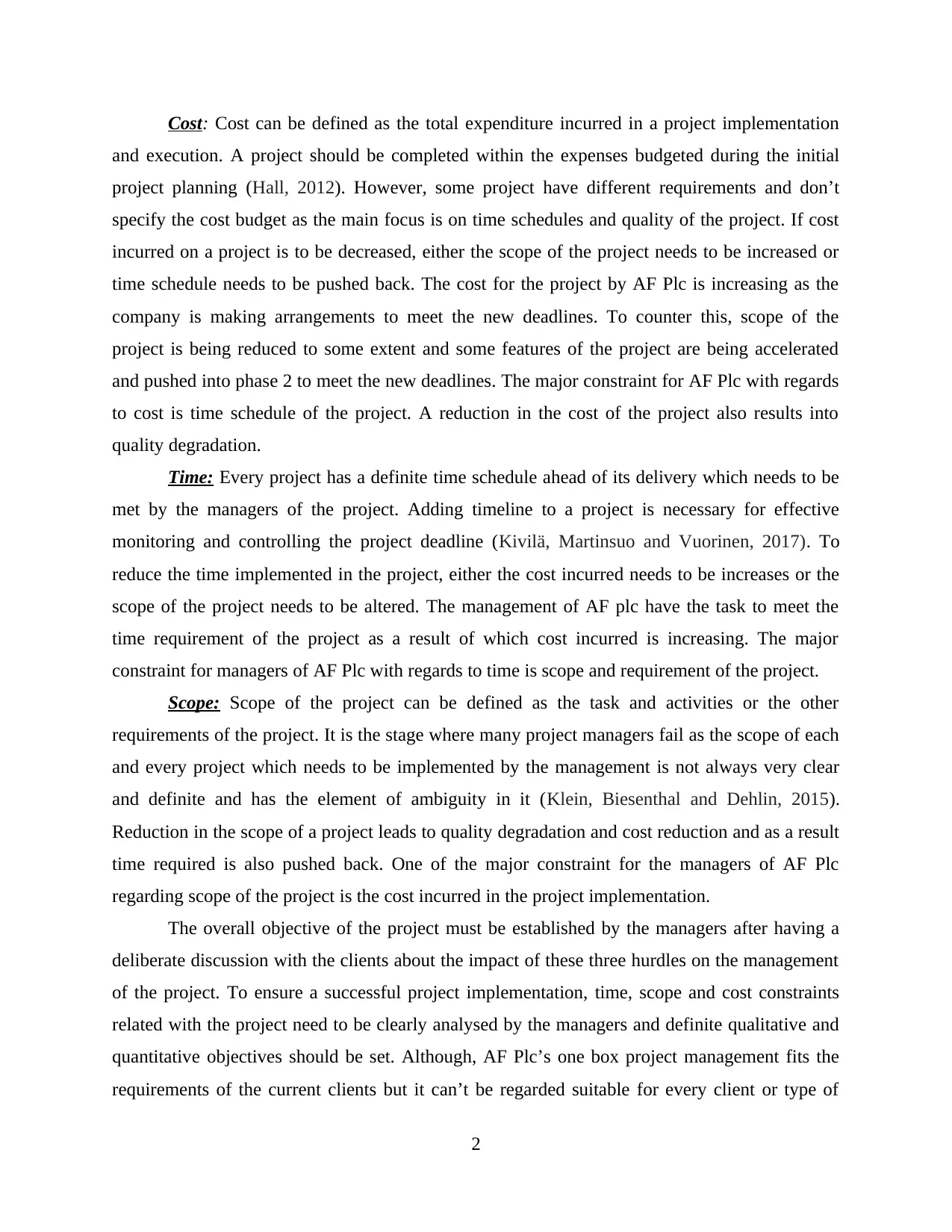
Cost: Cost can be defined as the total expenditure incurred in a project implementation
and execution. A project should be completed within the expenses budgeted during the initial
project planning (Hall, 2012). However, some project have different requirements and don’t
specify the cost budget as the main focus is on time schedules and quality of the project. If cost
incurred on a project is to be decreased, either the scope of the project needs to be increased or
time schedule needs to be pushed back. The cost for the project by AF Plc is increasing as the
company is making arrangements to meet the new deadlines. To counter this, scope of the
project is being reduced to some extent and some features of the project are being accelerated
and pushed into phase 2 to meet the new deadlines. The major constraint for AF Plc with regards
to cost is time schedule of the project. A reduction in the cost of the project also results into
quality degradation.
Time: Every project has a definite time schedule ahead of its delivery which needs to be
met by the managers of the project. Adding timeline to a project is necessary for effective
monitoring and controlling the project deadline (Kivilä, Martinsuo and Vuorinen, 2017). To
reduce the time implemented in the project, either the cost incurred needs to be increases or the
scope of the project needs to be altered. The management of AF plc have the task to meet the
time requirement of the project as a result of which cost incurred is increasing. The major
constraint for managers of AF Plc with regards to time is scope and requirement of the project.
Scope: Scope of the project can be defined as the task and activities or the other
requirements of the project. It is the stage where many project managers fail as the scope of each
and every project which needs to be implemented by the management is not always very clear
and definite and has the element of ambiguity in it (Klein, Biesenthal and Dehlin, 2015).
Reduction in the scope of a project leads to quality degradation and cost reduction and as a result
time required is also pushed back. One of the major constraint for the managers of AF Plc
regarding scope of the project is the cost incurred in the project implementation.
The overall objective of the project must be established by the managers after having a
deliberate discussion with the clients about the impact of these three hurdles on the management
of the project. To ensure a successful project implementation, time, scope and cost constraints
related with the project need to be clearly analysed by the managers and definite qualitative and
quantitative objectives should be set. Although, AF Plc’s one box project management fits the
requirements of the current clients but it can’t be regarded suitable for every client or type of
2
and execution. A project should be completed within the expenses budgeted during the initial
project planning (Hall, 2012). However, some project have different requirements and don’t
specify the cost budget as the main focus is on time schedules and quality of the project. If cost
incurred on a project is to be decreased, either the scope of the project needs to be increased or
time schedule needs to be pushed back. The cost for the project by AF Plc is increasing as the
company is making arrangements to meet the new deadlines. To counter this, scope of the
project is being reduced to some extent and some features of the project are being accelerated
and pushed into phase 2 to meet the new deadlines. The major constraint for AF Plc with regards
to cost is time schedule of the project. A reduction in the cost of the project also results into
quality degradation.
Time: Every project has a definite time schedule ahead of its delivery which needs to be
met by the managers of the project. Adding timeline to a project is necessary for effective
monitoring and controlling the project deadline (Kivilä, Martinsuo and Vuorinen, 2017). To
reduce the time implemented in the project, either the cost incurred needs to be increases or the
scope of the project needs to be altered. The management of AF plc have the task to meet the
time requirement of the project as a result of which cost incurred is increasing. The major
constraint for managers of AF Plc with regards to time is scope and requirement of the project.
Scope: Scope of the project can be defined as the task and activities or the other
requirements of the project. It is the stage where many project managers fail as the scope of each
and every project which needs to be implemented by the management is not always very clear
and definite and has the element of ambiguity in it (Klein, Biesenthal and Dehlin, 2015).
Reduction in the scope of a project leads to quality degradation and cost reduction and as a result
time required is also pushed back. One of the major constraint for the managers of AF Plc
regarding scope of the project is the cost incurred in the project implementation.
The overall objective of the project must be established by the managers after having a
deliberate discussion with the clients about the impact of these three hurdles on the management
of the project. To ensure a successful project implementation, time, scope and cost constraints
related with the project need to be clearly analysed by the managers and definite qualitative and
quantitative objectives should be set. Although, AF Plc’s one box project management fits the
requirements of the current clients but it can’t be regarded suitable for every client or type of
2
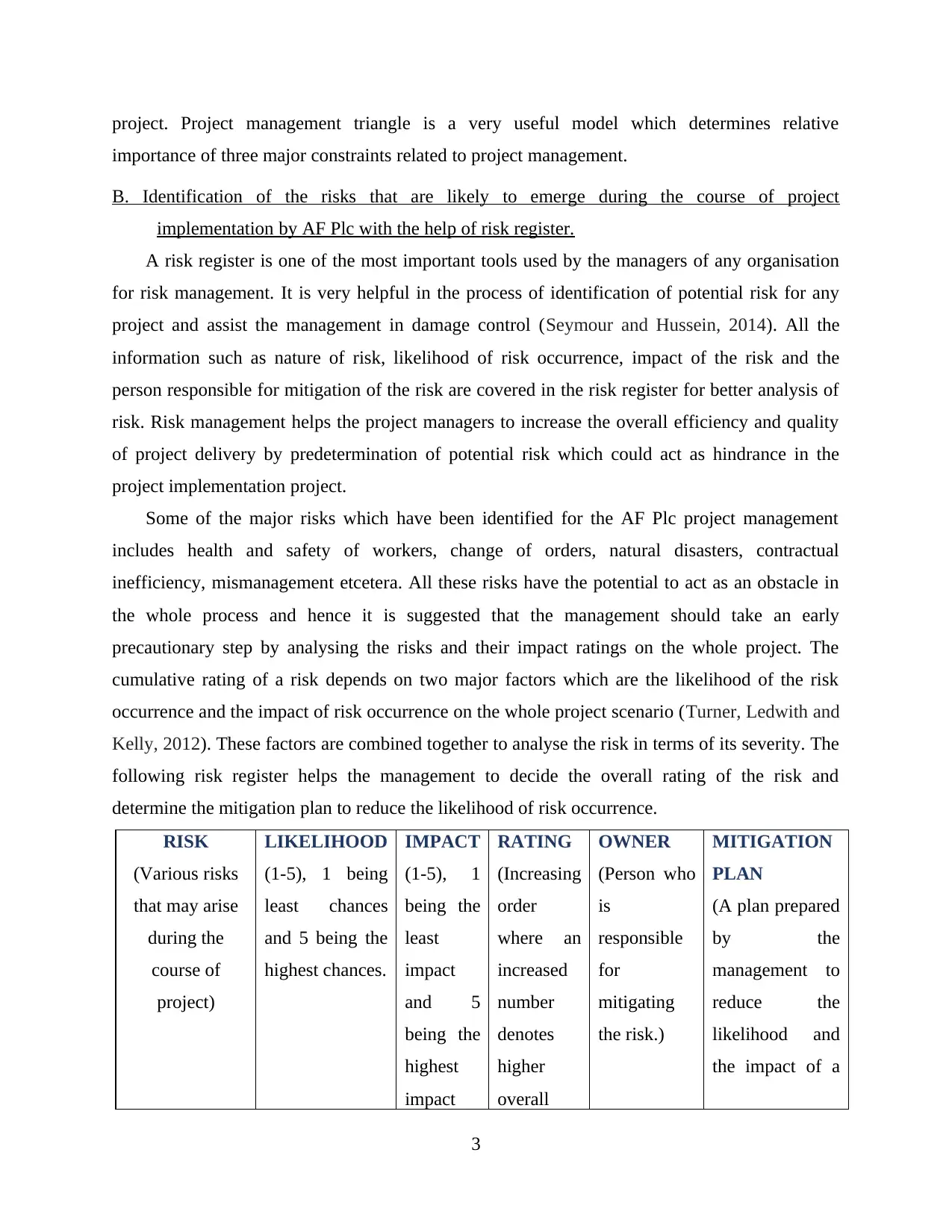
project. Project management triangle is a very useful model which determines relative
importance of three major constraints related to project management.
B. Identification of the risks that are likely to emerge during the course of project
implementation by AF Plc with the help of risk register.
A risk register is one of the most important tools used by the managers of any organisation
for risk management. It is very helpful in the process of identification of potential risk for any
project and assist the management in damage control (Seymour and Hussein, 2014). All the
information such as nature of risk, likelihood of risk occurrence, impact of the risk and the
person responsible for mitigation of the risk are covered in the risk register for better analysis of
risk. Risk management helps the project managers to increase the overall efficiency and quality
of project delivery by predetermination of potential risk which could act as hindrance in the
project implementation project.
Some of the major risks which have been identified for the AF Plc project management
includes health and safety of workers, change of orders, natural disasters, contractual
inefficiency, mismanagement etcetera. All these risks have the potential to act as an obstacle in
the whole process and hence it is suggested that the management should take an early
precautionary step by analysing the risks and their impact ratings on the whole project. The
cumulative rating of a risk depends on two major factors which are the likelihood of the risk
occurrence and the impact of risk occurrence on the whole project scenario (Turner, Ledwith and
Kelly, 2012). These factors are combined together to analyse the risk in terms of its severity. The
following risk register helps the management to decide the overall rating of the risk and
determine the mitigation plan to reduce the likelihood of risk occurrence.
RISK
(Various risks
that may arise
during the
course of
project)
LIKELIHOOD
(1-5), 1 being
least chances
and 5 being the
highest chances.
IMPACT
(1-5), 1
being the
least
impact
and 5
being the
highest
impact
RATING
(Increasing
order
where an
increased
number
denotes
higher
overall
OWNER
(Person who
is
responsible
for
mitigating
the risk.)
MITIGATION
PLAN
(A plan prepared
by the
management to
reduce the
likelihood and
the impact of a
3
importance of three major constraints related to project management.
B. Identification of the risks that are likely to emerge during the course of project
implementation by AF Plc with the help of risk register.
A risk register is one of the most important tools used by the managers of any organisation
for risk management. It is very helpful in the process of identification of potential risk for any
project and assist the management in damage control (Seymour and Hussein, 2014). All the
information such as nature of risk, likelihood of risk occurrence, impact of the risk and the
person responsible for mitigation of the risk are covered in the risk register for better analysis of
risk. Risk management helps the project managers to increase the overall efficiency and quality
of project delivery by predetermination of potential risk which could act as hindrance in the
project implementation project.
Some of the major risks which have been identified for the AF Plc project management
includes health and safety of workers, change of orders, natural disasters, contractual
inefficiency, mismanagement etcetera. All these risks have the potential to act as an obstacle in
the whole process and hence it is suggested that the management should take an early
precautionary step by analysing the risks and their impact ratings on the whole project. The
cumulative rating of a risk depends on two major factors which are the likelihood of the risk
occurrence and the impact of risk occurrence on the whole project scenario (Turner, Ledwith and
Kelly, 2012). These factors are combined together to analyse the risk in terms of its severity. The
following risk register helps the management to decide the overall rating of the risk and
determine the mitigation plan to reduce the likelihood of risk occurrence.
RISK
(Various risks
that may arise
during the
course of
project)
LIKELIHOOD
(1-5), 1 being
least chances
and 5 being the
highest chances.
IMPACT
(1-5), 1
being the
least
impact
and 5
being the
highest
impact
RATING
(Increasing
order
where an
increased
number
denotes
higher
overall
OWNER
(Person who
is
responsible
for
mitigating
the risk.)
MITIGATION
PLAN
(A plan prepared
by the
management to
reduce the
likelihood and
the impact of a
3
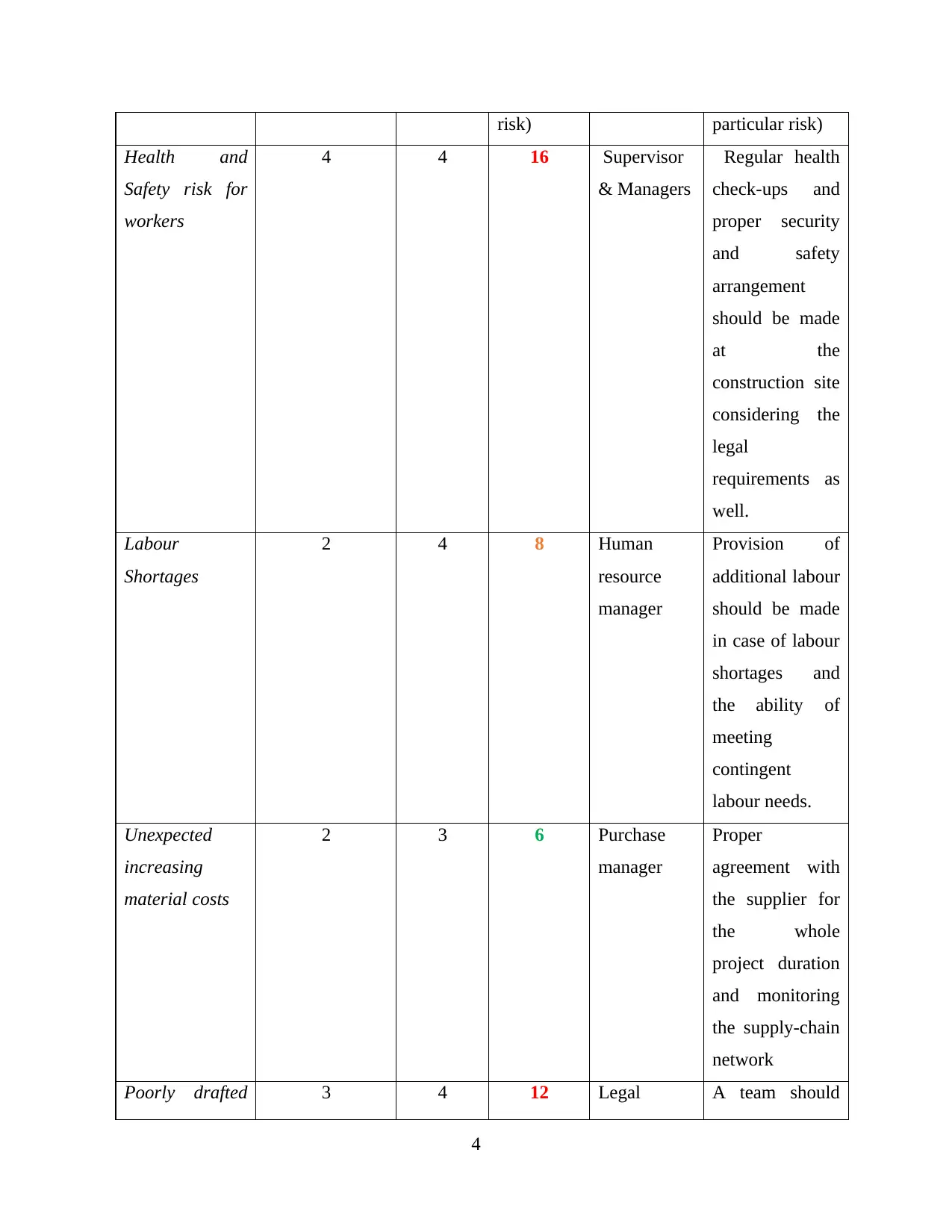
risk) particular risk)
Health and
Safety risk for
workers
4 4 16 Supervisor
& Managers
Regular health
check-ups and
proper security
and safety
arrangement
should be made
at the
construction site
considering the
legal
requirements as
well.
Labour
Shortages
2 4 8 Human
resource
manager
Provision of
additional labour
should be made
in case of labour
shortages and
the ability of
meeting
contingent
labour needs.
Unexpected
increasing
material costs
2 3 6 Purchase
manager
Proper
agreement with
the supplier for
the whole
project duration
and monitoring
the supply-chain
network
Poorly drafted 3 4 12 Legal A team should
4
Health and
Safety risk for
workers
4 4 16 Supervisor
& Managers
Regular health
check-ups and
proper security
and safety
arrangement
should be made
at the
construction site
considering the
legal
requirements as
well.
Labour
Shortages
2 4 8 Human
resource
manager
Provision of
additional labour
should be made
in case of labour
shortages and
the ability of
meeting
contingent
labour needs.
Unexpected
increasing
material costs
2 3 6 Purchase
manager
Proper
agreement with
the supplier for
the whole
project duration
and monitoring
the supply-chain
network
Poorly drafted 3 4 12 Legal A team should
4
Paraphrase This Document
Need a fresh take? Get an instant paraphrase of this document with our AI Paraphraser

contracts department be employed for
scanning the
legal horizon
and contractual
capacity of the
project.
Natural
disasters
1 5 5 Management Insurance
against natural
disasters can be
used for
reducing the
impact of risk to
a great extent.
Theft of
equipment
3 4 12 Project
Manager
A complete
security
arrangement has
to be made for
guarding the
materials and
machinery
during the whole
project period
such as
installation of
cameras at the
site.
Unknown site
conditions
3 3 9 Supervisor Scope of the
project should
be clearly
understood and
proper
5
scanning the
legal horizon
and contractual
capacity of the
project.
Natural
disasters
1 5 5 Management Insurance
against natural
disasters can be
used for
reducing the
impact of risk to
a great extent.
Theft of
equipment
3 4 12 Project
Manager
A complete
security
arrangement has
to be made for
guarding the
materials and
machinery
during the whole
project period
such as
installation of
cameras at the
site.
Unknown site
conditions
3 3 9 Supervisor Scope of the
project should
be clearly
understood and
proper
5

inspection of site
should be done
before
commencing the
project.
Change in
orders
3 4 12 Project
manager
Project manager
has to set clear
expectations
with the client
regarding
project
requirements
and
consequences of
change of orders
in future.
However, there
should be a little
element of
flexibility also to
alter project
needs to some
extent.
Availability of
materials
2 4 8 Purchase
manager
Arrangements
need to be made
for ensuring
smooth
operations and
production
process with the
help of regular
6
should be done
before
commencing the
project.
Change in
orders
3 4 12 Project
manager
Project manager
has to set clear
expectations
with the client
regarding
project
requirements
and
consequences of
change of orders
in future.
However, there
should be a little
element of
flexibility also to
alter project
needs to some
extent.
Availability of
materials
2 4 8 Purchase
manager
Arrangements
need to be made
for ensuring
smooth
operations and
production
process with the
help of regular
6
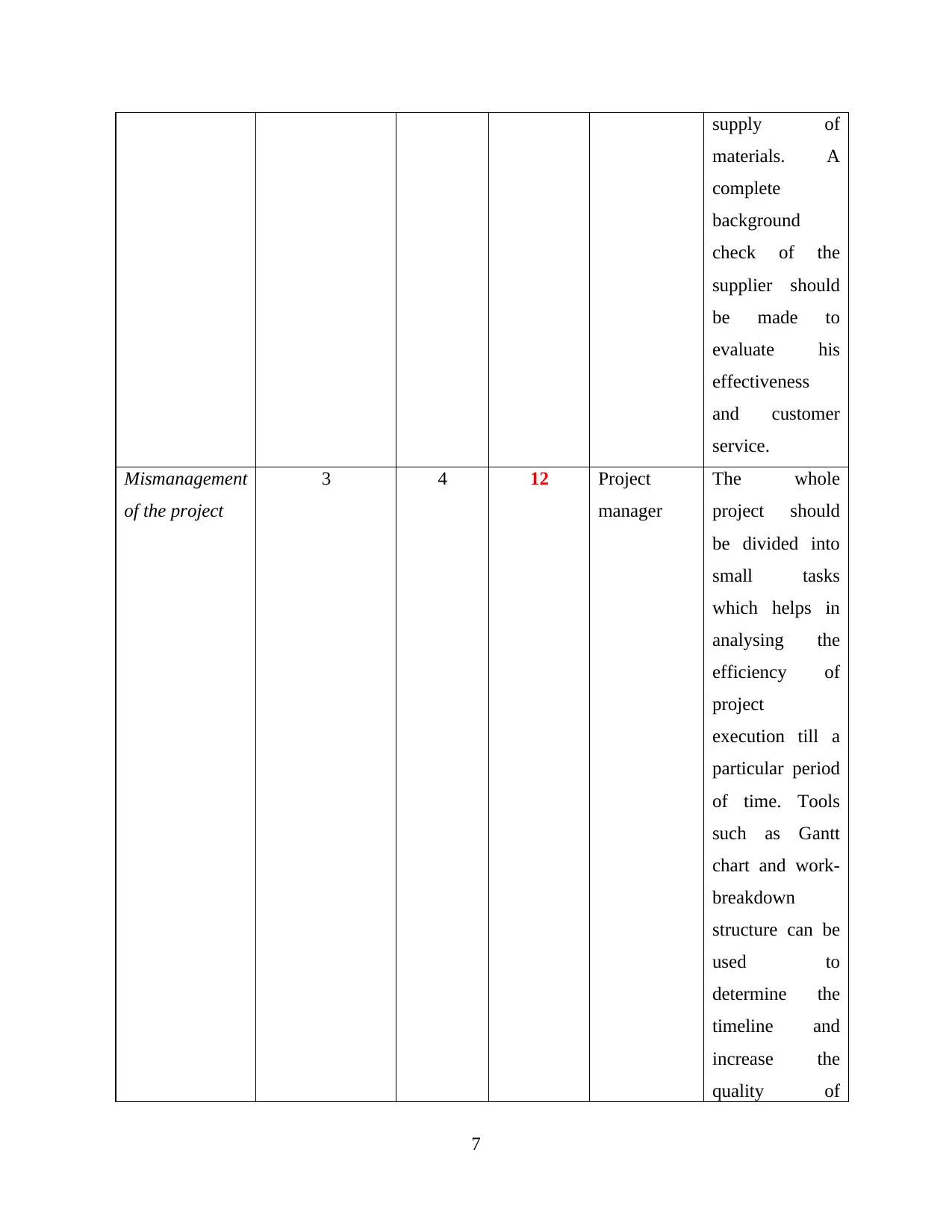
supply of
materials. A
complete
background
check of the
supplier should
be made to
evaluate his
effectiveness
and customer
service.
Mismanagement
of the project
3 4 12 Project
manager
The whole
project should
be divided into
small tasks
which helps in
analysing the
efficiency of
project
execution till a
particular period
of time. Tools
such as Gantt
chart and work-
breakdown
structure can be
used to
determine the
timeline and
increase the
quality of
7
materials. A
complete
background
check of the
supplier should
be made to
evaluate his
effectiveness
and customer
service.
Mismanagement
of the project
3 4 12 Project
manager
The whole
project should
be divided into
small tasks
which helps in
analysing the
efficiency of
project
execution till a
particular period
of time. Tools
such as Gantt
chart and work-
breakdown
structure can be
used to
determine the
timeline and
increase the
quality of
7
Secure Best Marks with AI Grader
Need help grading? Try our AI Grader for instant feedback on your assignments.
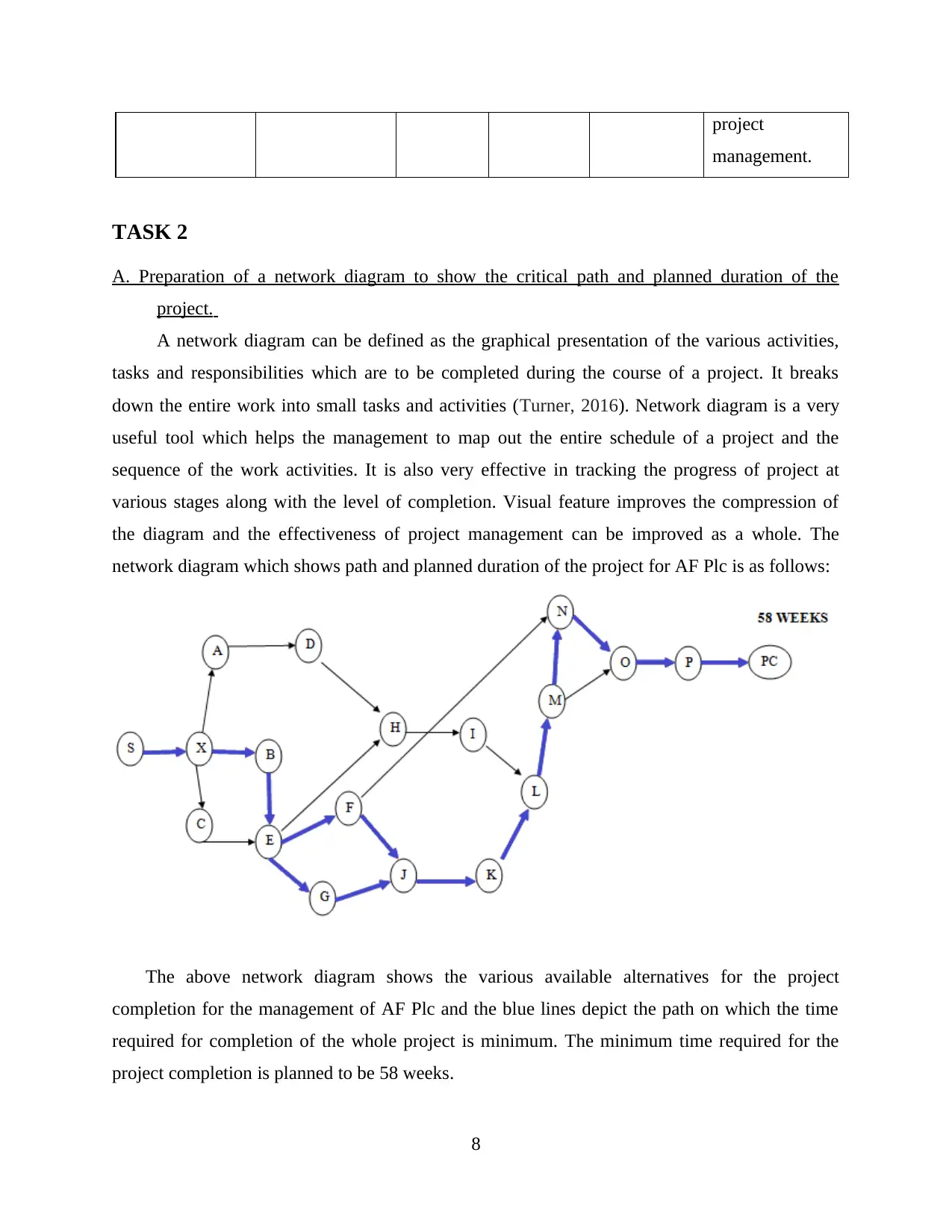
project
management.
TASK 2
A. Preparation of a network diagram to show the critical path and planned duration of the
project.
A network diagram can be defined as the graphical presentation of the various activities,
tasks and responsibilities which are to be completed during the course of a project. It breaks
down the entire work into small tasks and activities (Turner, 2016). Network diagram is a very
useful tool which helps the management to map out the entire schedule of a project and the
sequence of the work activities. It is also very effective in tracking the progress of project at
various stages along with the level of completion. Visual feature improves the compression of
the diagram and the effectiveness of project management can be improved as a whole. The
network diagram which shows path and planned duration of the project for AF Plc is as follows:
The above network diagram shows the various available alternatives for the project
completion for the management of AF Plc and the blue lines depict the path on which the time
required for completion of the whole project is minimum. The minimum time required for the
project completion is planned to be 58 weeks.
8
management.
TASK 2
A. Preparation of a network diagram to show the critical path and planned duration of the
project.
A network diagram can be defined as the graphical presentation of the various activities,
tasks and responsibilities which are to be completed during the course of a project. It breaks
down the entire work into small tasks and activities (Turner, 2016). Network diagram is a very
useful tool which helps the management to map out the entire schedule of a project and the
sequence of the work activities. It is also very effective in tracking the progress of project at
various stages along with the level of completion. Visual feature improves the compression of
the diagram and the effectiveness of project management can be improved as a whole. The
network diagram which shows path and planned duration of the project for AF Plc is as follows:
The above network diagram shows the various available alternatives for the project
completion for the management of AF Plc and the blue lines depict the path on which the time
required for completion of the whole project is minimum. The minimum time required for the
project completion is planned to be 58 weeks.
8
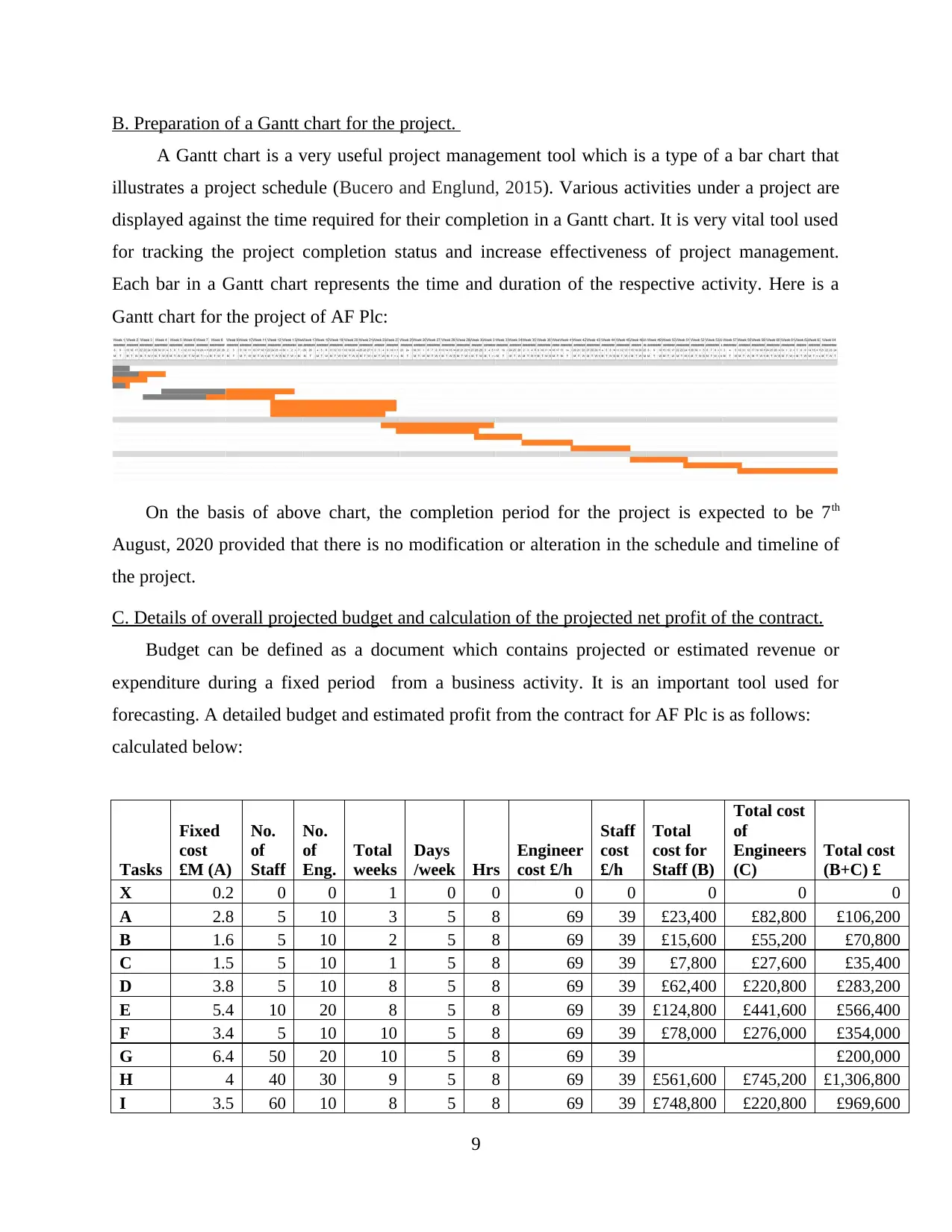
B. Preparation of a Gantt chart for the project.
A Gantt chart is a very useful project management tool which is a type of a bar chart that
illustrates a project schedule (Bucero and Englund, 2015). Various activities under a project are
displayed against the time required for their completion in a Gantt chart. It is very vital tool used
for tracking the project completion status and increase effectiveness of project management.
Each bar in a Gantt chart represents the time and duration of the respective activity. Here is a
Gantt chart for the project of AF Plc:
On the basis of above chart, the completion period for the project is expected to be 7th
August, 2020 provided that there is no modification or alteration in the schedule and timeline of
the project.
C. Details of overall projected budget and calculation of the projected net profit of the contract.
Budget can be defined as a document which contains projected or estimated revenue or
expenditure during a fixed period from a business activity. It is an important tool used for
forecasting. A detailed budget and estimated profit from the contract for AF Plc is as follows:
calculated below:
Tasks
Fixed
cost
£M (A)
No.
of
Staff
No.
of
Eng.
Total
weeks
Days
/week Hrs
Engineer
cost £/h
Staff
cost
£/h
Total
cost for
Staff (B)
Total cost
of
Engineers
(C)
Total cost
(B+C) £
X 0.2 0 0 1 0 0 0 0 0 0 0
A 2.8 5 10 3 5 8 69 39 £23,400 £82,800 £106,200
B 1.6 5 10 2 5 8 69 39 £15,600 £55,200 £70,800
C 1.5 5 10 1 5 8 69 39 £7,800 £27,600 £35,400
D 3.8 5 10 8 5 8 69 39 £62,400 £220,800 £283,200
E 5.4 10 20 8 5 8 69 39 £124,800 £441,600 £566,400
F 3.4 5 10 10 5 8 69 39 £78,000 £276,000 £354,000
G 6.4 50 20 10 5 8 69 39 £200,000
H 4 40 30 9 5 8 69 39 £561,600 £745,200 £1,306,800
I 3.5 60 10 8 5 8 69 39 £748,800 £220,800 £969,600
9
A Gantt chart is a very useful project management tool which is a type of a bar chart that
illustrates a project schedule (Bucero and Englund, 2015). Various activities under a project are
displayed against the time required for their completion in a Gantt chart. It is very vital tool used
for tracking the project completion status and increase effectiveness of project management.
Each bar in a Gantt chart represents the time and duration of the respective activity. Here is a
Gantt chart for the project of AF Plc:
On the basis of above chart, the completion period for the project is expected to be 7th
August, 2020 provided that there is no modification or alteration in the schedule and timeline of
the project.
C. Details of overall projected budget and calculation of the projected net profit of the contract.
Budget can be defined as a document which contains projected or estimated revenue or
expenditure during a fixed period from a business activity. It is an important tool used for
forecasting. A detailed budget and estimated profit from the contract for AF Plc is as follows:
calculated below:
Tasks
Fixed
cost
£M (A)
No.
of
Staff
No.
of
Eng.
Total
weeks
Days
/week Hrs
Engineer
cost £/h
Staff
cost
£/h
Total
cost for
Staff (B)
Total cost
of
Engineers
(C)
Total cost
(B+C) £
X 0.2 0 0 1 0 0 0 0 0 0 0
A 2.8 5 10 3 5 8 69 39 £23,400 £82,800 £106,200
B 1.6 5 10 2 5 8 69 39 £15,600 £55,200 £70,800
C 1.5 5 10 1 5 8 69 39 £7,800 £27,600 £35,400
D 3.8 5 10 8 5 8 69 39 £62,400 £220,800 £283,200
E 5.4 10 20 8 5 8 69 39 £124,800 £441,600 £566,400
F 3.4 5 10 10 5 8 69 39 £78,000 £276,000 £354,000
G 6.4 50 20 10 5 8 69 39 £200,000
H 4 40 30 9 5 8 69 39 £561,600 £745,200 £1,306,800
I 3.5 60 10 8 5 8 69 39 £748,800 £220,800 £969,600
9

J 2.2 20 8 6 5 8 69 39 £187,200 £132,480 £319,680
K 2.5 5 10 4 5 8 69 39 £31,200 £110,400 £141,600
L 3.1 50 25 6 5 8 69 39 £468,000 £414,000 £882,000
M 2.2 5 10 4 5 8 69 39 £31,200 £110,400 £141,600
N 2.7 6 10 5 5 8 69 39 £46,800 £138,000 £184,800
O 2.1 20 6 6 5 8 69 39 £187,200 £99,360 £286,560
P 1.2 16 6 6 5 8 69 39 £149,760 £99,360 £249,120
£48.6M £6,097,760
Adjustments to task costs:
Less: Christmas
off 10 60 2 5 8 69 39 £55,200 £187,200 £242,400
Add: other staff cost £462,250
£48.6M £6.31M
Total cost for the project = £48.6M + £6.31M
= £54.91M
Other staff costs:
Project management
support
Project manager
Project
planner
Rate
£/Week
No. of
weeks
Total
cost
2 2 5,500 17 £93,500
1 1 2,000 40 £80,000
Commercial Manager
1 2,750 17 £46,750
2 2,750 44 £242,000
£462,250
Calculation of estimated profit from the contract:
Bonus / working day No. of days earlier Total extra bonus
Bonus £50,000 42 £2,100,000
Budget allotted £58,500,000
Total Revenue £60,600,000
Less: Total cost £54,917,610
Surplus: £5,682,390
10
K 2.5 5 10 4 5 8 69 39 £31,200 £110,400 £141,600
L 3.1 50 25 6 5 8 69 39 £468,000 £414,000 £882,000
M 2.2 5 10 4 5 8 69 39 £31,200 £110,400 £141,600
N 2.7 6 10 5 5 8 69 39 £46,800 £138,000 £184,800
O 2.1 20 6 6 5 8 69 39 £187,200 £99,360 £286,560
P 1.2 16 6 6 5 8 69 39 £149,760 £99,360 £249,120
£48.6M £6,097,760
Adjustments to task costs:
Less: Christmas
off 10 60 2 5 8 69 39 £55,200 £187,200 £242,400
Add: other staff cost £462,250
£48.6M £6.31M
Total cost for the project = £48.6M + £6.31M
= £54.91M
Other staff costs:
Project management
support
Project manager
Project
planner
Rate
£/Week
No. of
weeks
Total
cost
2 2 5,500 17 £93,500
1 1 2,000 40 £80,000
Commercial Manager
1 2,750 17 £46,750
2 2,750 44 £242,000
£462,250
Calculation of estimated profit from the contract:
Bonus / working day No. of days earlier Total extra bonus
Bonus £50,000 42 £2,100,000
Budget allotted £58,500,000
Total Revenue £60,600,000
Less: Total cost £54,917,610
Surplus: £5,682,390
10
Paraphrase This Document
Need a fresh take? Get an instant paraphrase of this document with our AI Paraphraser
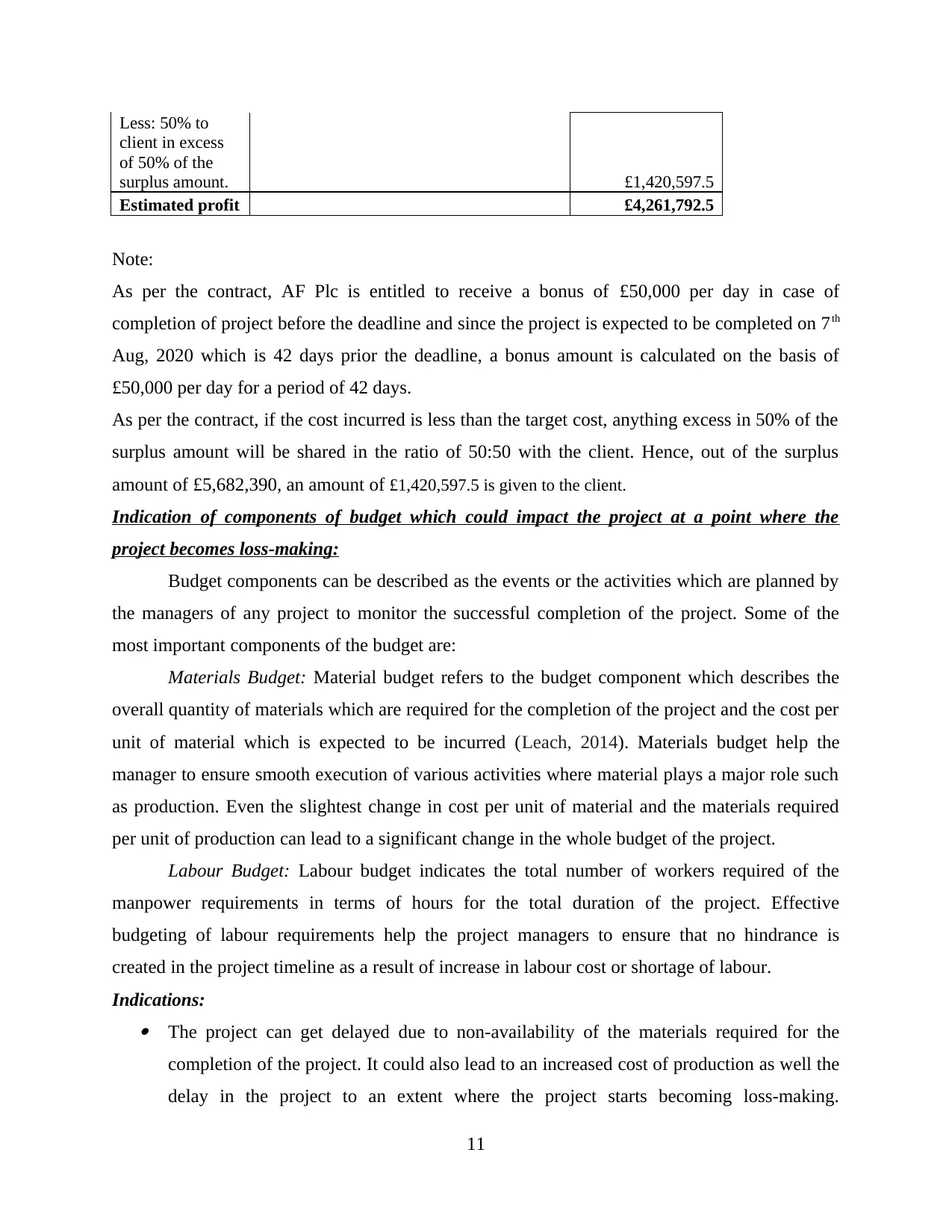
Less: 50% to
client in excess
of 50% of the
surplus amount. £1,420,597.5
Estimated profit £4,261,792.5
Note:
As per the contract, AF Plc is entitled to receive a bonus of £50,000 per day in case of
completion of project before the deadline and since the project is expected to be completed on 7th
Aug, 2020 which is 42 days prior the deadline, a bonus amount is calculated on the basis of
£50,000 per day for a period of 42 days.
As per the contract, if the cost incurred is less than the target cost, anything excess in 50% of the
surplus amount will be shared in the ratio of 50:50 with the client. Hence, out of the surplus
amount of £5,682,390, an amount of £1,420,597.5 is given to the client.
Indication of components of budget which could impact the project at a point where the
project becomes loss-making:
Budget components can be described as the events or the activities which are planned by
the managers of any project to monitor the successful completion of the project. Some of the
most important components of the budget are:
Materials Budget: Material budget refers to the budget component which describes the
overall quantity of materials which are required for the completion of the project and the cost per
unit of material which is expected to be incurred (Leach, 2014). Materials budget help the
manager to ensure smooth execution of various activities where material plays a major role such
as production. Even the slightest change in cost per unit of material and the materials required
per unit of production can lead to a significant change in the whole budget of the project.
Labour Budget: Labour budget indicates the total number of workers required of the
manpower requirements in terms of hours for the total duration of the project. Effective
budgeting of labour requirements help the project managers to ensure that no hindrance is
created in the project timeline as a result of increase in labour cost or shortage of labour.
Indications: The project can get delayed due to non-availability of the materials required for the
completion of the project. It could also lead to an increased cost of production as well the
delay in the project to an extent where the project starts becoming loss-making.
11
client in excess
of 50% of the
surplus amount. £1,420,597.5
Estimated profit £4,261,792.5
Note:
As per the contract, AF Plc is entitled to receive a bonus of £50,000 per day in case of
completion of project before the deadline and since the project is expected to be completed on 7th
Aug, 2020 which is 42 days prior the deadline, a bonus amount is calculated on the basis of
£50,000 per day for a period of 42 days.
As per the contract, if the cost incurred is less than the target cost, anything excess in 50% of the
surplus amount will be shared in the ratio of 50:50 with the client. Hence, out of the surplus
amount of £5,682,390, an amount of £1,420,597.5 is given to the client.
Indication of components of budget which could impact the project at a point where the
project becomes loss-making:
Budget components can be described as the events or the activities which are planned by
the managers of any project to monitor the successful completion of the project. Some of the
most important components of the budget are:
Materials Budget: Material budget refers to the budget component which describes the
overall quantity of materials which are required for the completion of the project and the cost per
unit of material which is expected to be incurred (Leach, 2014). Materials budget help the
manager to ensure smooth execution of various activities where material plays a major role such
as production. Even the slightest change in cost per unit of material and the materials required
per unit of production can lead to a significant change in the whole budget of the project.
Labour Budget: Labour budget indicates the total number of workers required of the
manpower requirements in terms of hours for the total duration of the project. Effective
budgeting of labour requirements help the project managers to ensure that no hindrance is
created in the project timeline as a result of increase in labour cost or shortage of labour.
Indications: The project can get delayed due to non-availability of the materials required for the
completion of the project. It could also lead to an increased cost of production as well the
delay in the project to an extent where the project starts becoming loss-making.
11

Availability of materials can be affected by factors such as market conditions,
government control etcetera. A provision of material in advance should be made. Shortage of labour and increasing labour costs can be the reason for delay in project due
to decreased working hours and productivity levels for the project. Ab abundance of
labour during the initial commencement period shall not lead the management to avoid or
ignore the problems or constraints which can be created due to a shortage of labour.
TASK 3
A. Comparing the actual progress with the planned progress using Gantt Chart.
The following table is prepared with the help of Gantt Chart to compare the actual progress
with the planned progress after a period of 17 weeks.
Up to 17 Weeks
Task
Actual Progress
%
Planned progress
%
X (Project Initiation) 100 100
A (Commission
Design of Factory) 100 100
B (Commission
outline Design of
Automation
Equipment) 100 100
C (Commission
outline Design -
Inverter Product) 100 100
D (Detailed design
of Factory) 80 100
E (Detailed design of
Automation
Equipment and
Inverter Product) 100 100
F (Commission and
develop Software
for Automation
equipment and
Inverter Product) 35 40
G (Manufacture
Automation
equipment) 35 40
12
government control etcetera. A provision of material in advance should be made. Shortage of labour and increasing labour costs can be the reason for delay in project due
to decreased working hours and productivity levels for the project. Ab abundance of
labour during the initial commencement period shall not lead the management to avoid or
ignore the problems or constraints which can be created due to a shortage of labour.
TASK 3
A. Comparing the actual progress with the planned progress using Gantt Chart.
The following table is prepared with the help of Gantt Chart to compare the actual progress
with the planned progress after a period of 17 weeks.
Up to 17 Weeks
Task
Actual Progress
%
Planned progress
%
X (Project Initiation) 100 100
A (Commission
Design of Factory) 100 100
B (Commission
outline Design of
Automation
Equipment) 100 100
C (Commission
outline Design -
Inverter Product) 100 100
D (Detailed design
of Factory) 80 100
E (Detailed design of
Automation
Equipment and
Inverter Product) 100 100
F (Commission and
develop Software
for Automation
equipment and
Inverter Product) 35 40
G (Manufacture
Automation
equipment) 35 40
12
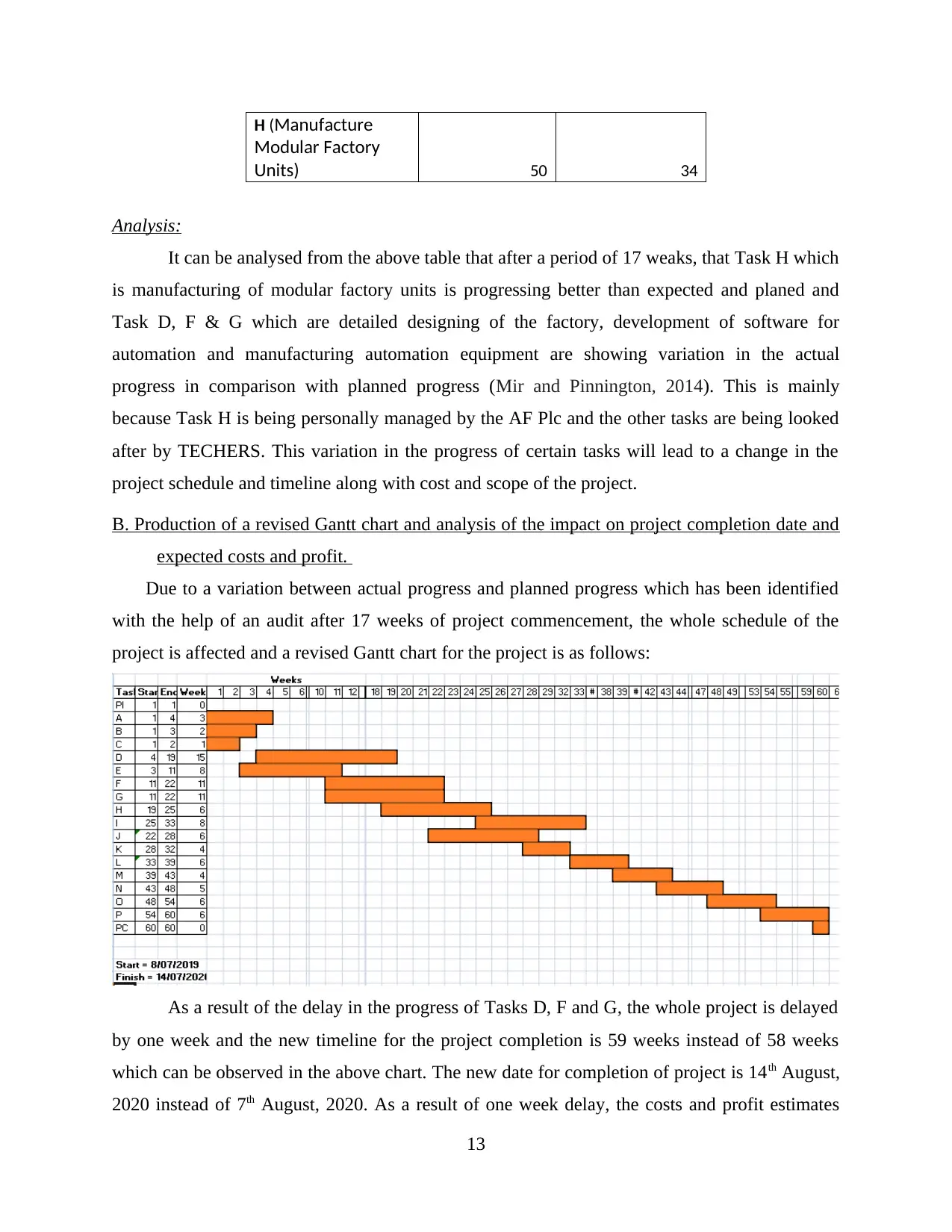
H (Manufacture
Modular Factory
Units) 50 34
Analysis:
It can be analysed from the above table that after a period of 17 weaks, that Task H which
is manufacturing of modular factory units is progressing better than expected and planed and
Task D, F & G which are detailed designing of the factory, development of software for
automation and manufacturing automation equipment are showing variation in the actual
progress in comparison with planned progress (Mir and Pinnington, 2014). This is mainly
because Task H is being personally managed by the AF Plc and the other tasks are being looked
after by TECHERS. This variation in the progress of certain tasks will lead to a change in the
project schedule and timeline along with cost and scope of the project.
B. Production of a revised Gantt chart and analysis of the impact on project completion date and
expected costs and profit.
Due to a variation between actual progress and planned progress which has been identified
with the help of an audit after 17 weeks of project commencement, the whole schedule of the
project is affected and a revised Gantt chart for the project is as follows:
As a result of the delay in the progress of Tasks D, F and G, the whole project is delayed
by one week and the new timeline for the project completion is 59 weeks instead of 58 weeks
which can be observed in the above chart. The new date for completion of project is 14th August,
2020 instead of 7th August, 2020. As a result of one week delay, the costs and profit estimates
13
Modular Factory
Units) 50 34
Analysis:
It can be analysed from the above table that after a period of 17 weaks, that Task H which
is manufacturing of modular factory units is progressing better than expected and planed and
Task D, F & G which are detailed designing of the factory, development of software for
automation and manufacturing automation equipment are showing variation in the actual
progress in comparison with planned progress (Mir and Pinnington, 2014). This is mainly
because Task H is being personally managed by the AF Plc and the other tasks are being looked
after by TECHERS. This variation in the progress of certain tasks will lead to a change in the
project schedule and timeline along with cost and scope of the project.
B. Production of a revised Gantt chart and analysis of the impact on project completion date and
expected costs and profit.
Due to a variation between actual progress and planned progress which has been identified
with the help of an audit after 17 weeks of project commencement, the whole schedule of the
project is affected and a revised Gantt chart for the project is as follows:
As a result of the delay in the progress of Tasks D, F and G, the whole project is delayed
by one week and the new timeline for the project completion is 59 weeks instead of 58 weeks
which can be observed in the above chart. The new date for completion of project is 14th August,
2020 instead of 7th August, 2020. As a result of one week delay, the costs and profit estimates
13
Secure Best Marks with AI Grader
Need help grading? Try our AI Grader for instant feedback on your assignments.

related to the contract are also bound to change. The impact of this delay on the costs and profit
is estimated to be as follows:
Other staff costs:
Project management
support
Project manager
Project
planner
Rate
£/Week
No. of
weeks
Total
cost
2 2 5,500 17 £93,500
1 1 2,000 41 £82,000
Commercial Manager
1 2,750 17 £46,750
2 2,750 45 £247,500
£469,750
Total cost of the project = £48.6M + £6.31M
= £54.91M
Calculation of revised estimated profit from the contract:
Bonus / working day No. of days earlier Total extra bonus
Bonus £50,000 35 £1,750,000
Budget allotted £58,500,000
Total Revenue £60,600,000
Less: Total cost £54,925,110
Surplus: £5,324,890
Less: 50% to
client in excess
of 50% of the
surplus amount. £1,331,222.5
Estimated profit £3,993,667.5
Due to a delay in the completion period of the project by one week or 7 days, the amount of bonus
has reduced to £1,750,000. However, the company is still in a profitable position but the overall
cost of the project is also increased as a result of one-week delay in the project schedule to
£54,925,110 and the difference between the profit between both the periods is £268,125. So the
company has to face a potential loss of profit up to the extent of £268,125 as a result of one-week
14
is estimated to be as follows:
Other staff costs:
Project management
support
Project manager
Project
planner
Rate
£/Week
No. of
weeks
Total
cost
2 2 5,500 17 £93,500
1 1 2,000 41 £82,000
Commercial Manager
1 2,750 17 £46,750
2 2,750 45 £247,500
£469,750
Total cost of the project = £48.6M + £6.31M
= £54.91M
Calculation of revised estimated profit from the contract:
Bonus / working day No. of days earlier Total extra bonus
Bonus £50,000 35 £1,750,000
Budget allotted £58,500,000
Total Revenue £60,600,000
Less: Total cost £54,925,110
Surplus: £5,324,890
Less: 50% to
client in excess
of 50% of the
surplus amount. £1,331,222.5
Estimated profit £3,993,667.5
Due to a delay in the completion period of the project by one week or 7 days, the amount of bonus
has reduced to £1,750,000. However, the company is still in a profitable position but the overall
cost of the project is also increased as a result of one-week delay in the project schedule to
£54,925,110 and the difference between the profit between both the periods is £268,125. So the
company has to face a potential loss of profit up to the extent of £268,125 as a result of one-week
14
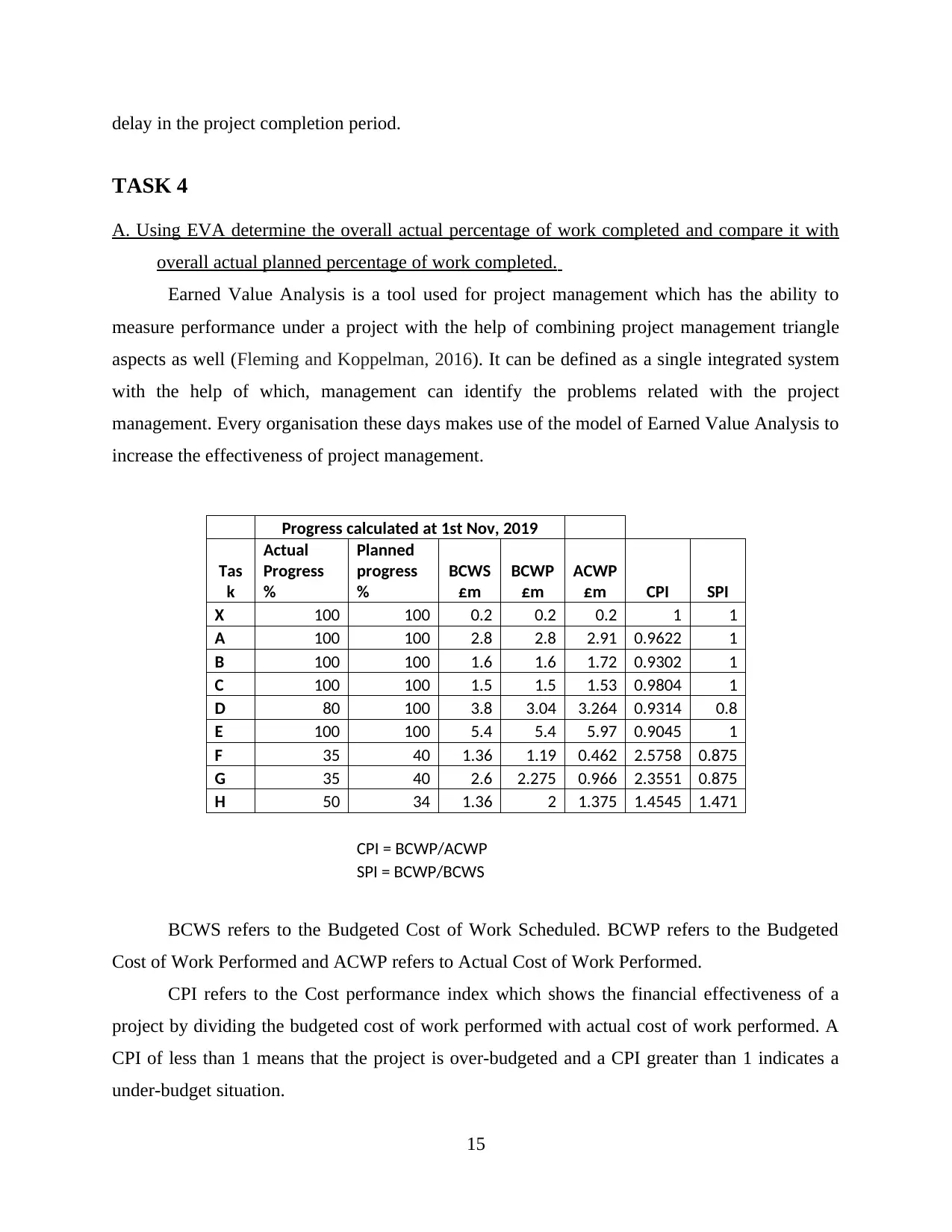
delay in the project completion period.
TASK 4
A. Using EVA determine the overall actual percentage of work completed and compare it with
overall actual planned percentage of work completed.
Earned Value Analysis is a tool used for project management which has the ability to
measure performance under a project with the help of combining project management triangle
aspects as well (Fleming and Koppelman, 2016). It can be defined as a single integrated system
with the help of which, management can identify the problems related with the project
management. Every organisation these days makes use of the model of Earned Value Analysis to
increase the effectiveness of project management.
BCWS refers to the Budgeted Cost of Work Scheduled. BCWP refers to the Budgeted
Cost of Work Performed and ACWP refers to Actual Cost of Work Performed.
CPI refers to the Cost performance index which shows the financial effectiveness of a
project by dividing the budgeted cost of work performed with actual cost of work performed. A
CPI of less than 1 means that the project is over-budgeted and a CPI greater than 1 indicates a
under-budget situation.
15
Progress calculated at 1st Nov, 2019
Tas
k
Actual
Progress
%
Planned
progress
%
BCWS
£m
BCWP
£m
ACWP
£m CPI SPI
X 100 100 0.2 0.2 0.2 1 1
A 100 100 2.8 2.8 2.91 0.9622 1
B 100 100 1.6 1.6 1.72 0.9302 1
C 100 100 1.5 1.5 1.53 0.9804 1
D 80 100 3.8 3.04 3.264 0.9314 0.8
E 100 100 5.4 5.4 5.97 0.9045 1
F 35 40 1.36 1.19 0.462 2.5758 0.875
G 35 40 2.6 2.275 0.966 2.3551 0.875
H 50 34 1.36 2 1.375 1.4545 1.471
CPI = BCWP/ACWP
SPI = BCWP/BCWS
TASK 4
A. Using EVA determine the overall actual percentage of work completed and compare it with
overall actual planned percentage of work completed.
Earned Value Analysis is a tool used for project management which has the ability to
measure performance under a project with the help of combining project management triangle
aspects as well (Fleming and Koppelman, 2016). It can be defined as a single integrated system
with the help of which, management can identify the problems related with the project
management. Every organisation these days makes use of the model of Earned Value Analysis to
increase the effectiveness of project management.
BCWS refers to the Budgeted Cost of Work Scheduled. BCWP refers to the Budgeted
Cost of Work Performed and ACWP refers to Actual Cost of Work Performed.
CPI refers to the Cost performance index which shows the financial effectiveness of a
project by dividing the budgeted cost of work performed with actual cost of work performed. A
CPI of less than 1 means that the project is over-budgeted and a CPI greater than 1 indicates a
under-budget situation.
15
Progress calculated at 1st Nov, 2019
Tas
k
Actual
Progress
%
Planned
progress
%
BCWS
£m
BCWP
£m
ACWP
£m CPI SPI
X 100 100 0.2 0.2 0.2 1 1
A 100 100 2.8 2.8 2.91 0.9622 1
B 100 100 1.6 1.6 1.72 0.9302 1
C 100 100 1.5 1.5 1.53 0.9804 1
D 80 100 3.8 3.04 3.264 0.9314 0.8
E 100 100 5.4 5.4 5.97 0.9045 1
F 35 40 1.36 1.19 0.462 2.5758 0.875
G 35 40 2.6 2.275 0.966 2.3551 0.875
H 50 34 1.36 2 1.375 1.4545 1.471
CPI = BCWP/ACWP
SPI = BCWP/BCWS

SPI refers to the Schedule Performance Index which determines how close a project is in
terms of being completed as per the planned schedule (Meredith, Mantel Jr and Shafer, 2017). It
is obtained by dividing the Budgeted Cost of Work Performed by Budgeted Cost of Work
Scheduled. A SPI of less than 1 indicates that the project is behind schedule and is not ideal
whereas a SPI greater than 1 indicates that the project is ahead of time schedule.
B. Create a project final spend and date using EAC method derived from Earned Value Analysis.
£M
Budget at Completion (BAC) 58.5
Actual Cost (AC) 54.91
Planned Value (PV) @ 90% 52.65
Earned value 58.5
CPI (EV/AC) 1.06538
Estimate at completion (EAC)
BAC/CPI 54.91
Original contract value 58.5
EAC 54.91
Projected net profit 3.59
C. Recommendation for which of the options should be accepted and which should be declined.
Acceleration can be defined as the process under which efforts are made to speed up the
working so that a particular activity or the whole project can be completed within the time
duration specified (Burke, 2013). AF Plc has 5 different options for accelerating the working
speed. A cost-benefit analysis is being done to decide which option should be preferred by the
project manager and which offer should be declined.
Tas
k Weeks
Cost
£'000
Cost/Week
(A)
Bonus
/Week
Total bonus
(B)
Total
benefit (B-
A)
F 3 200 66.66666667 250 750 550
G 3 105 35 250 750 645
I 2 75 37.5 250 500 425
N 1 25 25 250 250 225
P 2 35 17.5 250 500 465
Conclusion:
16
terms of being completed as per the planned schedule (Meredith, Mantel Jr and Shafer, 2017). It
is obtained by dividing the Budgeted Cost of Work Performed by Budgeted Cost of Work
Scheduled. A SPI of less than 1 indicates that the project is behind schedule and is not ideal
whereas a SPI greater than 1 indicates that the project is ahead of time schedule.
B. Create a project final spend and date using EAC method derived from Earned Value Analysis.
£M
Budget at Completion (BAC) 58.5
Actual Cost (AC) 54.91
Planned Value (PV) @ 90% 52.65
Earned value 58.5
CPI (EV/AC) 1.06538
Estimate at completion (EAC)
BAC/CPI 54.91
Original contract value 58.5
EAC 54.91
Projected net profit 3.59
C. Recommendation for which of the options should be accepted and which should be declined.
Acceleration can be defined as the process under which efforts are made to speed up the
working so that a particular activity or the whole project can be completed within the time
duration specified (Burke, 2013). AF Plc has 5 different options for accelerating the working
speed. A cost-benefit analysis is being done to decide which option should be preferred by the
project manager and which offer should be declined.
Tas
k Weeks
Cost
£'000
Cost/Week
(A)
Bonus
/Week
Total bonus
(B)
Total
benefit (B-
A)
F 3 200 66.66666667 250 750 550
G 3 105 35 250 750 645
I 2 75 37.5 250 500 425
N 1 25 25 250 250 225
P 2 35 17.5 250 500 465
Conclusion:
16
Paraphrase This Document
Need a fresh take? Get an instant paraphrase of this document with our AI Paraphraser

In the above table, cost per week and bonus per week have been calculated to evaluate the
different options available for acceleration. Activity P has the minimum cost per week of £17.5k
but this option can’t be selected on the sole basis of minimum cost per week. A brief evaluation
of the profitability suggests that Activity G has the highest profitability of £645K which should
be selected as the option for acceleration by the project manager of PF Alc.
17
different options available for acceleration. Activity P has the minimum cost per week of £17.5k
but this option can’t be selected on the sole basis of minimum cost per week. A brief evaluation
of the profitability suggests that Activity G has the highest profitability of £645K which should
be selected as the option for acceleration by the project manager of PF Alc.
17
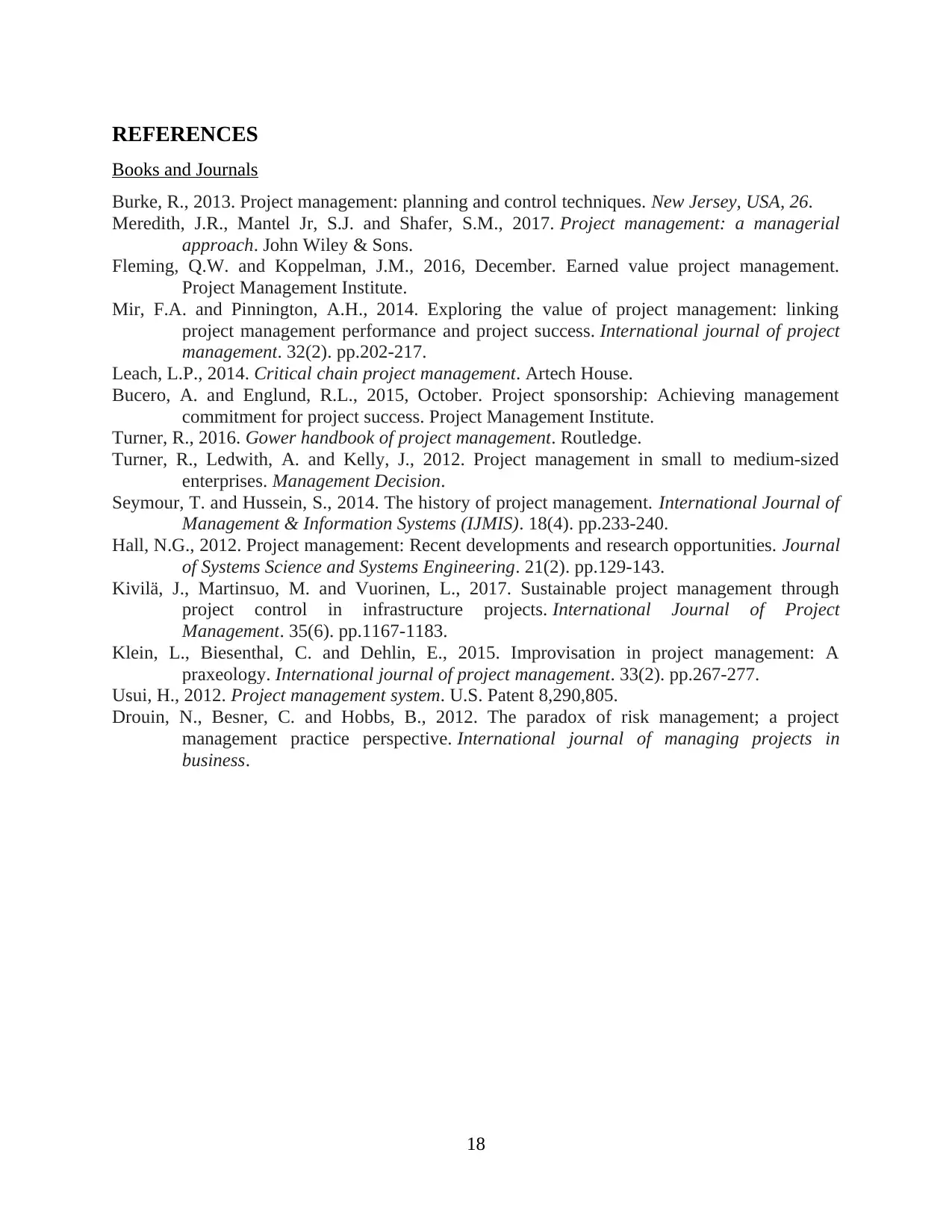
REFERENCES
Books and Journals
Burke, R., 2013. Project management: planning and control techniques. New Jersey, USA, 26.
Meredith, J.R., Mantel Jr, S.J. and Shafer, S.M., 2017. Project management: a managerial
approach. John Wiley & Sons.
Fleming, Q.W. and Koppelman, J.M., 2016, December. Earned value project management.
Project Management Institute.
Mir, F.A. and Pinnington, A.H., 2014. Exploring the value of project management: linking
project management performance and project success. International journal of project
management. 32(2). pp.202-217.
Leach, L.P., 2014. Critical chain project management. Artech House.
Bucero, A. and Englund, R.L., 2015, October. Project sponsorship: Achieving management
commitment for project success. Project Management Institute.
Turner, R., 2016. Gower handbook of project management. Routledge.
Turner, R., Ledwith, A. and Kelly, J., 2012. Project management in small to medium‐sized
enterprises. Management Decision.
Seymour, T. and Hussein, S., 2014. The history of project management. International Journal of
Management & Information Systems (IJMIS). 18(4). pp.233-240.
Hall, N.G., 2012. Project management: Recent developments and research opportunities. Journal
of Systems Science and Systems Engineering. 21(2). pp.129-143.
Kivilä, J., Martinsuo, M. and Vuorinen, L., 2017. Sustainable project management through
project control in infrastructure projects. International Journal of Project
Management. 35(6). pp.1167-1183.
Klein, L., Biesenthal, C. and Dehlin, E., 2015. Improvisation in project management: A
praxeology. International journal of project management. 33(2). pp.267-277.
Usui, H., 2012. Project management system. U.S. Patent 8,290,805.
Drouin, N., Besner, C. and Hobbs, B., 2012. The paradox of risk management; a project
management practice perspective. International journal of managing projects in
business.
18
Books and Journals
Burke, R., 2013. Project management: planning and control techniques. New Jersey, USA, 26.
Meredith, J.R., Mantel Jr, S.J. and Shafer, S.M., 2017. Project management: a managerial
approach. John Wiley & Sons.
Fleming, Q.W. and Koppelman, J.M., 2016, December. Earned value project management.
Project Management Institute.
Mir, F.A. and Pinnington, A.H., 2014. Exploring the value of project management: linking
project management performance and project success. International journal of project
management. 32(2). pp.202-217.
Leach, L.P., 2014. Critical chain project management. Artech House.
Bucero, A. and Englund, R.L., 2015, October. Project sponsorship: Achieving management
commitment for project success. Project Management Institute.
Turner, R., 2016. Gower handbook of project management. Routledge.
Turner, R., Ledwith, A. and Kelly, J., 2012. Project management in small to medium‐sized
enterprises. Management Decision.
Seymour, T. and Hussein, S., 2014. The history of project management. International Journal of
Management & Information Systems (IJMIS). 18(4). pp.233-240.
Hall, N.G., 2012. Project management: Recent developments and research opportunities. Journal
of Systems Science and Systems Engineering. 21(2). pp.129-143.
Kivilä, J., Martinsuo, M. and Vuorinen, L., 2017. Sustainable project management through
project control in infrastructure projects. International Journal of Project
Management. 35(6). pp.1167-1183.
Klein, L., Biesenthal, C. and Dehlin, E., 2015. Improvisation in project management: A
praxeology. International journal of project management. 33(2). pp.267-277.
Usui, H., 2012. Project management system. U.S. Patent 8,290,805.
Drouin, N., Besner, C. and Hobbs, B., 2012. The paradox of risk management; a project
management practice perspective. International journal of managing projects in
business.
18
1 out of 21
Related Documents
Your All-in-One AI-Powered Toolkit for Academic Success.
+13062052269
info@desklib.com
Available 24*7 on WhatsApp / Email
![[object Object]](/_next/static/media/star-bottom.7253800d.svg)
Unlock your academic potential
© 2024 | Zucol Services PVT LTD | All rights reserved.





